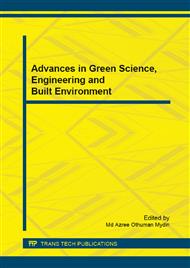p.347
p.351
p.355
p.359
p.363
p.367
p.371
p.375
p.379
Development of Microcontroller Based Potentiometric Transduction Circuit for a Continuous Fluid Level Sensor
Abstract:
This paper presents the development of microcontroller based potentiometric transduction circuit for a continuous fluid level sensor. The purpose system involved the integration between hardware and software subsystem. For hardware subsystem, the design of potentiometric circuit was tested with theoretical computation, simulation on Proteus VSM software and breadboard circuit. This finding was then used to develop interface for the analog-to-digital converter. For software subsystem, the water level indicator system has been developed using ATMEGA2560 by converting the output from potentiometric circuit into water level with a look-up table. It computes the digital data conversion into desired reading and displays data through the second hardware subsystem which is liquid crystal display. A potentiometric indicator for a continuous fluid level sensor to detect level of water ponding on the flat roof was developed. It was comprised of a potentiometric transduction stage and follower stage. From the experiment, it was shown that the potentiometric circuit designed was able to report changes in the water in a different level. The integration of the continuous fluid level sensor with the potentiometric indicator system will have a significant impact on the practice of sensor integration.
Info:
Periodical:
Pages:
379-383
Citation:
Online since:
March 2015
Keywords:
Price:
Сopyright:
© 2015 Trans Tech Publications Ltd. All Rights Reserved
Share:
Citation:


